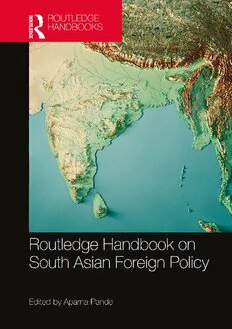
Routledge Handbook on South Asian Foreign Policy PDF
Preview Routledge Handbook on South Asian Foreign Policy
ROUTLEDGE HANDBOOK ON SOUTH ASIAN FOREIGN POLICY This handbook offers a comprehensive overview of South Asian foreign policy, examining the complex history and present state of South Asian foreign policy, the foreign policy of the countries of the region, as well as their relationships with their neighbours and key external players, such as China and the United States, in an effort to understand South Asia’s place in the world order. It illustrates the future trajectory of foreign policy in the region and analyses the future of regional arrangements like SAARC (South Asian Association for Regional Cooperation) and BIMSTEC. The handbook is structured in five parts, each representing a focused area of enquiry: • Foreign Policy • Relations within South Asia • Relations within Indo-Pacific • Relations with China, Europe, and the United States • Security A carefully selected collection of 26 chapters written by experts on South Asian foreign, economic, and security policy, this handbook provides an objective yet accessible overview of the history and current state of foreign policy of each country and the region. It is an authoritative reference work for academics and students as well as international think tanks, research institutes, and non-governmental organisations working on South Asian Politics, Asian Politics, Foreign Politics, International Affairs, World History, and International Relations. Aparna Pande is Director of the Initiative on the Future of India and South Asia at the Hudson Institute, USA. She is also the editor of the Routledge Handbook of Contemporary Pakistan (2017) and the author of Explaining Pakistan’s Foreign Policy (Routledge 2011). ROUTLEDGE HANDBOOK ON SOUTH ASIAN FOREIGN POLICY Edited by Aparna Pande First published 2022 by Routledge 2 Park Square, Milton Park, Abingdon, Oxon OX14 4RN and by Routledge 605 Third Avenue, New York, NY 10158 Routledge is an imprint of the Taylor & Francis Group, an informa business © 2022 selection and editorial matter, Aparna Pande; individual chapters, the contributors The right of Aparna Pande to be identified as the author of the editorial material, and of the authors for their individual chapters, has been asserted in accordance with sections 77 and 78 of the Copyright, Designs and Patents Act 1988. All rights reserved. No part of this book may be reprinted or reproduced or utilised in any form or by any electronic, mechanical, or other means, now known or hereafter invented, including photocopying and recording, or in any information storage or retrieval system, without permission in writing from the publishers. Trademark notice: Product or corporate names may be trademarks or registered trademarks, and are used only for identification and explanation without intent to infringe. British Library Cataloguing-in-Publication Data A catalogue record for this book is available from the British Library Library of Congress Cataloging-in-Publication Data A catalog record has been requested for this book ISBN: 978-0-367-15068-6 (hbk) ISBN: 978-1-032-05032-4 (pbk) ISBN: 978-0-429-05480-8 (ebk) DOI: 10.4324/9780429054808 Typeset in Bembo by Deanta Global Publishing Services, Chennai, India This book is dedicated to my paternal and maternal grandparents, Dr Purushottam Pande and Smt Tara Pande, and Sri Pitambar Datt Pande and Smt Bhagwati Pande. CONTENTS List of figures x List of tables xi List of contributors xii Acknowledgements xix Foreign Policy in South Asia: Promise and Peril 1 Aparna Pande, Raj Dhage, and Ojus Jain PART I Foreign Policy 17 1 India’s Foreign Policy Realignments 19 By Dhruva Jaishankar 2 Pakistan’s Foreign Policy: The More Things Change, the More They Stay the Same 35 Waqas Waheed 3 Sleepwalking into a Great Power Rivalry: The Evolution of Sri Lanka’s Foreign Policy in the Twenty-first Century 46 Ranga Jayasuriya 4 Nepal’s Foreign Policy since 1950 66 Prem Raj Khanal and Indivar Paudel 5 History of Foreign Invasions and the Afghan Response 81 Kanishka Nawabi vii Contents PART II Relations within South Asia 95 6 India’s South Asia Policy: Shifts and Continuities 97 Harsh V. Pant and Kriti M. Shah 7 The Changing Landscape of India–Pakistan–Afghanistan Relationship 111 Vinay Kaura 8 The Kashmir Matrix: Strategy/Policy Formulation in India and Pakistan 125 Priyanka Singh 9 India–Afghanistan Relations: Pragmatism towards Political Normalisation 139 Prakhar Sharma 10 Nepal–Bangladesh, Bhutan, and Maldives Relations 152 Apekshya Shah 11 Transformation of India and Bangladesh Relations and Challenges Ahead 170 Joyeeta Bhattacharjee PART III Relations within Indo-Pacifc 181 12 BIMSTEC: India’s Emerging Foreign Policy Fulcrum 183 Pinak R. Chakravarty 13 India’s Iran Policy: Civilisational Past, Complicated Present 202 Sumitha Narayanan Kutty 14 From Distant Relatives to Close Partners: India’s Relations with Australia and New Zealand 216 Miguel A. Híjar-Chiapa 15 Influence and Hedging: China’s Engagement in South Asia 231 Manoj Kewalramani and Shibani Mehta 16 Rapid Development of India–Japan Cooperation: Its Chance and Challenges 248 Satoru Nagao viii Contents PART IV Relations with China, Europe, and the United States 267 17 The Transformation of the Indo-China Rivalry in the Twenty-First Century: The Rise of the Maritime Domain 269 Christopher K. Colley 18 India’s Strategic Policy towards China 283 Manjeet S. Pardesi 19 China–Pakistan Relations: Understanding Strategic Dimensions 298 Shalini Chawla 20 Caught between the United States and China: Critical Junctures in Pakistan’s Foreign Policy 313 Filippo Boni 21 Bangladesh–China Relations in an Era of Globalisation: Dynamics and Challenges 326 Delwar Hossain 22 Sri Lanka’s Foreign Policy: Past, Present, and Future: Infrastructure Diplomacy and Contemporary Chinese Affairs 344 Asanga Abeyagoonasekera 23 Nepal’s Relationship with the European Union 358 Girdhari Dahal 24 Nepal–U.S. Relations: The Indo-Pacific and Evolving Strategic Partnership in the Twenty-First-Century World 370 Rohit Karki PART V Security 385 25 Terrorism and Indian Foreign Policy 387 Manoj Joshi 26 Almost Parity: Understanding the India–Pakistan Conventional Military Balance 407 Arzan Tarapore Index 421 ix
